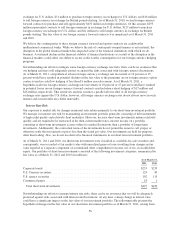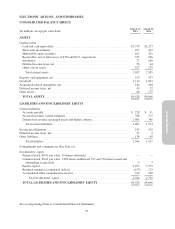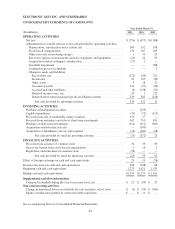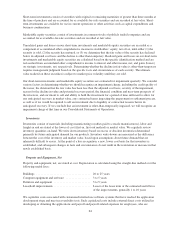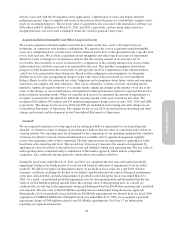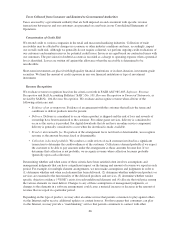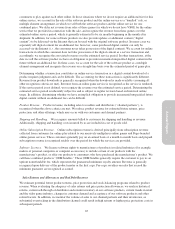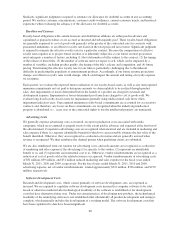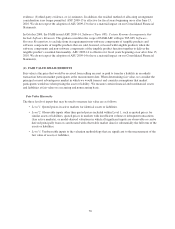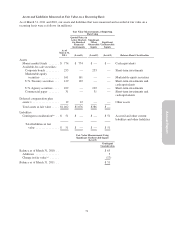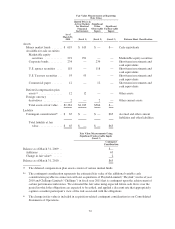Electronic Arts 2011 Annual Report Download - page 141
Download and view the complete annual report
Please find page 141 of the 2011 Electronic Arts annual report below. You can navigate through the pages in the report by either clicking on the pages listed below, or by using the keyword search tool below to find specific information within the annual report.
Annual Report
directly associated with the development of the applications. Capitalization of such costs begins when the
preliminary project stage is complete and ceases at the point in which the project is substantially complete and is
ready for its intended purpose. The net book value of capitalized costs associated with internal-use software was
$50 million and $37 million as of March 31, 2011 and 2010, respectively, and are being depreciated on a
straight-line basis over each asset’s estimated useful life, which is generally three years.
Acquisition-Related Intangibles and Other Long-Lived Assets
We record acquisition-related intangible assets that have finite useful lives, such as developed and core
technology, in connection with business combinations. We amortize the cost of acquisition-related intangible
assets on a straight-line basis over the lesser of their estimated useful lives or the agreement terms, typically from
two to fourteen years. We evaluate acquisition-related intangibles and other long-lived assets for impairment
whenever events or changes in circumstances indicate that the carrying amount of an asset may not be
recoverable. Recoverability of assets is measured by a comparison of the carrying amount of an asset to future
undiscounted net cash flows expected to be generated by the asset. This includes assumptions about future
prospects for the business that the asset relates to and typically involves computations of the estimated future
cash flows to be generated by these businesses. Based on these judgments and assumptions, we determine
whether we need to take an impairment charge to reduce the value of the asset stated on our Consolidated
Balance Sheets to reflect its estimated fair value. Judgments and assumptions about future values and remaining
useful lives are complex and often subjective. They can be affected by a variety of factors, including but not
limited to, significant negative industry or economic trends, significant changes in the manner of our use of the
assets or the strategy of our overall business and significant under-performance relative to expected historical or
projected future operating results. When we consider such assets to be impaired, the amount of impairment we
recognize is measured by the amount by which the carrying amount of the asset exceeds its fair value. We
recognized $14 million, $39 million and $25 million in impairment charges in fiscal years 2011, 2010 and 2009,
respectively. The charges for fiscal years 2010 and 2009 are included in restructuring and other charges in our
Consolidated Statements of Operations. The charges for fiscal year 2011 are included in restructuring and other
charges and research and development in our Consolidated Statements of Operations.
Goodwill
We are required to perform a two-step approach for testing goodwill for impairment for each reporting unit
annually, or whenever events or changes in circumstances indicate that fair value of a reporting unit is below its
carrying amount. Our reporting units are determined by the components of our operating segments that constitute
a business for which (1) discrete financial information is available and (2) segment management regularly
reviews the operating results of that component. The first step measures for impairment by applying fair value-
based tests at the reporting unit level. The second step (if necessary) measures the amount of impairment by
applying fair value-based tests to the individual assets and liabilities within each reporting unit. The fair value of
each reporting unit is estimated using a combination of the market approach, which utilizes comparable
companies’ data, and/or the income approach, which utilizes discounted cash flows.
During the fiscal years ended March 31, 2011 and 2010, we completed the first step of the annual goodwill
impairment testing in the fourth quarter of each year and found no indicators of impairment of our recorded
goodwill. We did not recognize an impairment charge on goodwill in fiscal years 2011 and 2010. Adverse
economic conditions, including the decline in our market capitalization and our expected financial performance
at the time, indicated that a potential impairment of goodwill existed during the fiscal year ended March 31,
2009. As a result, we performed goodwill impairment tests for our reporting units and determined that the fair
value of our EA Mobile reporting unit fell below the carrying value of that reporting unit. As a result, we
conducted the second step in the impairment testing and determined that the EA Mobile reporting unit’s goodwill
was impaired. The fair value of the EA Mobile reporting unit was determined using the income approach.
Substantially all of our goodwill associated with our EA Mobile reporting unit was derived from our fiscal 2006
acquisition of JAMDAT Mobile Inc. During the fiscal year ended March 31, 2009, we recognized a goodwill
impairment charge of $368 million related to our EA Mobile reporting unit. See Note 17 for information
regarding our segment information.
65



